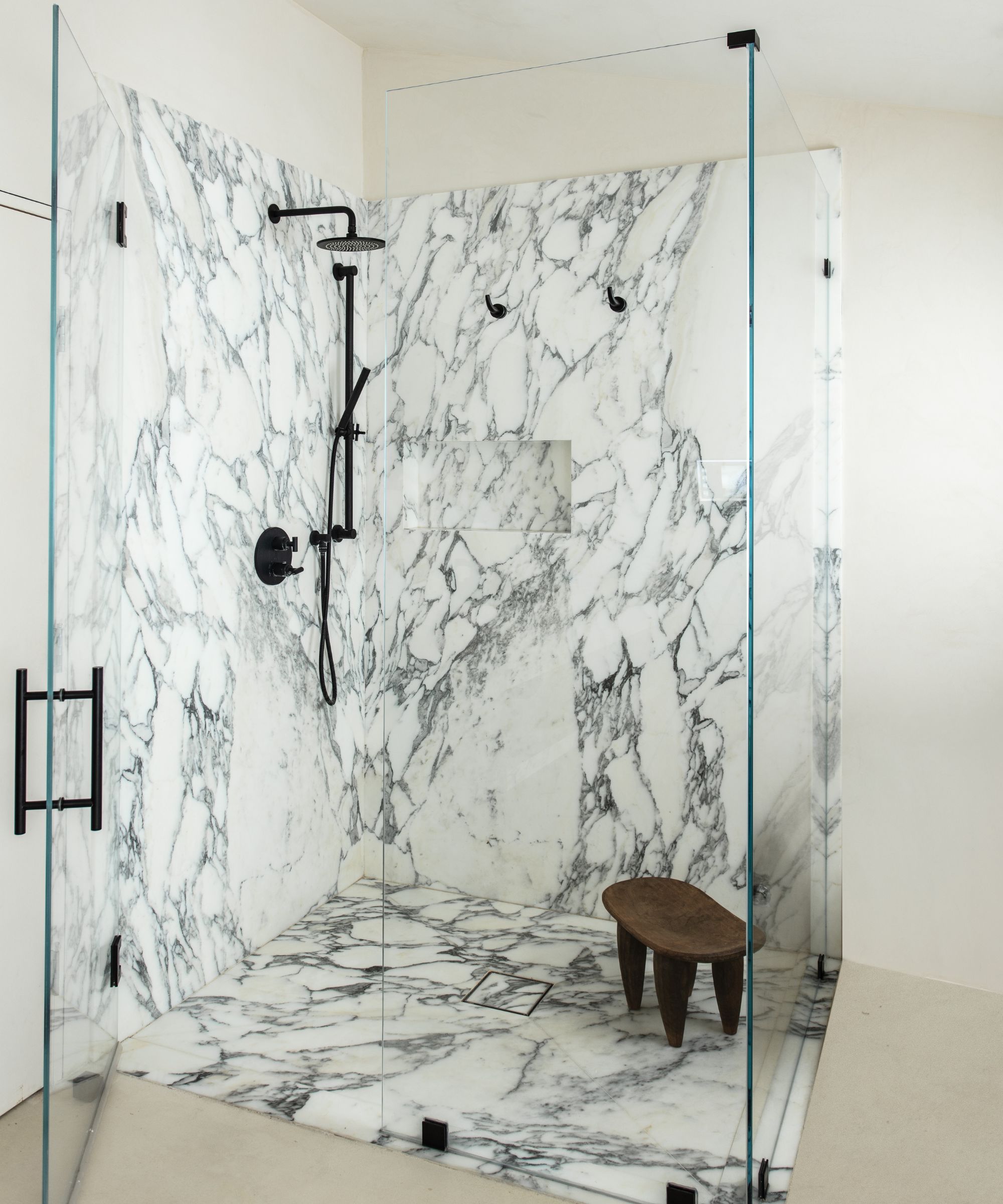How to fix a dripping showerhead – easy DIY tricks to stop that annoying leak
Discover the do-it-yourself remedies to the waste and annoyance a dripping showerhead causes


A dripping showerhead is a nuisance, but it can frequently be a problem you can fix yourself. DIY successfully and you don’t have to wait for a plumber.
Like unclogging a toilet or fixing a blocked sink, the knowhow to deal with a dripping showerhead is well worth acquiring so you can avoid calling in a pro for every plumbing issue. It’ll allow you to swiftly put a stop to the waste of water, and avoid the staining inside the shower that can be caused by the constant drip.
There are a few possible causes and we’ve asked the experts to explain what they might be along with how to fix a dripping showerhead here.
Easy fixes for a dripping showerhead
Like fixing a running toilet, tackling a dripping showerhead minimizes water wastage. And while unclogging a shower drain is an urgent issue if the bathroom threatens to flood, like unclogging a bathtub drain, a leaky showerhead remains a problem you should address.
Fix a leaky faucet and you can prevent the squandering of water and the same applies to a showerhead that’s dripping. To solve the problem, this is what you need to know.

What causes a showerhead to drip?
There are a few possible causes of a dripping showerhead. ‘Most showerheads drip after the water is shut off,’ explains Benjamin Fix, CEO and co-founder of sproos! ‘The main reason is that there is still water in the showerhead at this time, and the water is dripping due to gravity. Some companies have developed a technology called drop-stop that prevents this from happening. When the dripping continues, there is something wrong with the cartridge inside the shower valve.’
Other possible issues include those with washers. ‘Over time, the rubber washers, also called O-rings, inside the showerhead can degrade or become damaged, which will cause the shower head to leak,’ explains Allison Harrison, co-owner at Goodbee Plumbing, Drains and Water Treatment.
Mineral deposits can also cause problems. ‘Limescale or mineral buildup can obstruct the flow of water, leading to leaks, dripping, or uneven distribution,’ says Allison.
1. Tackle mineral buildup
Limescale can be the culprit when the showerhead is dripping rather than producing the expected flow of water. It blocks the holes in the showerhead, and this can result in water leaking out where it shouldn’t instead (plus you won’t enjoy a good shower).
To clean a showerhead of limescale turn off the water supply either to the shower if it has a shut-off valve or to the whole house if not, cover the drain to prevent anything falling down it, and remove the showerhead. Be prepared for some water to come out as you do so.
‘A deep soak and clean with a soft brush should help remove residue build up and grit and improve the water flow,’ explains Benjamin Fix. Put the showerhead into a bucket and cover it with white vinegar, and leave for an hour unless it has a gold, brass, or nickel finish in which case, leave it for 30 minutes maximum. Rinse thoroughly.
Use an old toothbrush to clean off any limescale that remains, then rinse again. Replace and run the shower to get rid of any lingering limescale.
2. Fix worn seals
A worn seal could be the cause of the shower problems. With the water supply off, disassemble the showerhead, and inspect and replace as necessary any worn parts.
‘Check the washer, O-rings and seals for signs of wear or damage,’ says Allison Harrison. ‘Replace them with new ones of the same size and type. Be sure you are replacing it with the correct size and type. It’s best to bring the ring to the hardware store to avoid trying to use the wrong product.’
3. Replace the shower valve cartridge
If yours is a shower with a single handle to control the flow of hot and cold water, the shower valve cartridge inside can become worn. This means that even when the water is off, it gets through and makes the showerhead drip. A cartridge like this can be replaced.
To remove the old version, once again turn off the water supply, then remove the handle, which is held by a small screw. Take off the trim plate. Next, remove the cap and cover, as required.
To remove the cartridge, you’ll need to follow the manufacturer’s instructions. ‘Your local hardware store should be able to explain and has the added benefit of providing you with the required tools and new cartridge for your replacement,’ says Benjamin Fix. Bear in mind that you might still have the instructions on replacing the cartridge from when you purchased the shower, or you can find them online, but in any case, you should take the worn cartridge to the hardware store to get the correct replacement.
Put the new cartridge in place of the worn model and reassemble following the manufacturer’s instructions. Problem not solved by a new cartridge? It may be time to call in a plumber.
FAQs
How long is normal for a shower to drip?
It is normal for a shower to drip for a few minutes after the water is turned off. That’s because there’s water left in the pipe after the flow is stopped and this will come out of the showerhead. However, if it keeps on dripping after this, and the water is completely shut off, then a fix is required.
Fixing a dripping showerhead can be a relatively straightforward task if it drips when it’s turned on. If it drips when it’s turned off (after allowing time for the water in the showerhead to find its way out), then it could still be an issue you can deal with yourself. ‘Regarding your home’s plumbing, a few things signal it can be a DIY job,’ says Allison Harrison. ‘These projects typically do not require you to open a wall, rip up any flooring, or completely remove an appliance.’ Not confident or can’t solve it? Call in a pro.
Sign up to the Homes & Gardens newsletter
Design expertise in your inbox – from inspiring decorating ideas and beautiful celebrity homes to practical gardening advice and shopping round-ups.

Sarah is a freelance journalist and editor. Previously executive editor of Ideal Home, she’s specialized in interiors, property and gardens for over 20 years, and covers interior design, house design, gardens, and cleaning and organizing a home for Homes & Gardens. She’s written for websites, including Houzz, Channel 4’s flagship website, 4Homes, and Future’s T3; national newspapers, including The Guardian; and magazines including Future’s Country Homes & Interiors, Homebuilding & Renovating, Period Living, and Style at Home, as well as House Beautiful, Good Homes, Grand Designs, Homes & Antiques, LandLove and The English Home among others. It’s no big surprise that she likes to put what she writes about into practice, and is a serial house renovator.
-
 The rumours are true, the NYC trend for fringes and trimmings is actually happening – they are the secret weapon for making a room look expensive
The rumours are true, the NYC trend for fringes and trimmings is actually happening – they are the secret weapon for making a room look expensiveA trim or a ruffle is the finishing touch that can take a scheme from ordinary to the extraordinary in an instant
By Jennifer Ebert Published
-
 How to grow impatiens – garden experts reveal the secrets to growing this shade-tolerant, sparkling summer plant
How to grow impatiens – garden experts reveal the secrets to growing this shade-tolerant, sparkling summer plantBoth 'Busy Lizzie' and 'New Guinea' impatiens can thrive in shady yards
By Ellen Wells Published